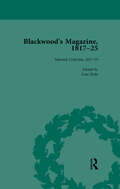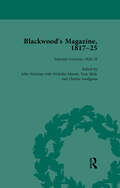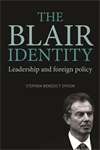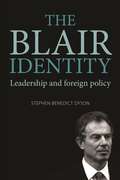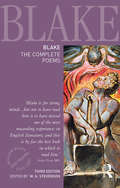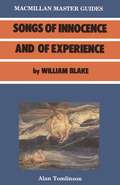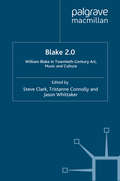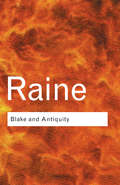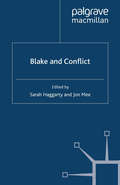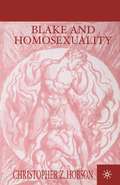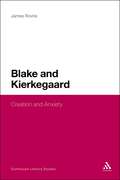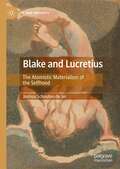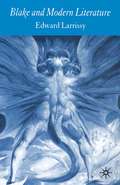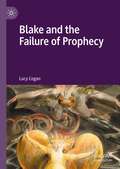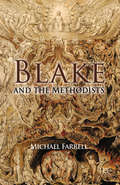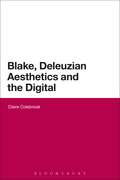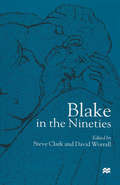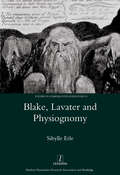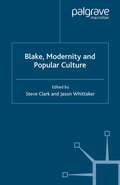- Table View
- List View
Blackwood's Magazine, 1817-25, Volume 5: Selections from Maga's Infancy
by Nicholas Mason John Strachan Anthony Jarrells Tom Mole Mark ParkerContextualizes and annotates the influential, scandalous, and entertaining texts which appeared in the Blackwood's Magazine between 1817 and 1825. This title features a detailed general introduction, volume introductions and endnotes, providing the reader with an understanding of the origins and early history of Blackwood's Magazine.
Blackwood's Magazine, 1817-25, Volume 5: Selections from Maga's Infancy
by Nicholas Mason John Strachan Anthony Jarrells Tom Mole Mark ParkerContextualizes and annotates the influential, scandalous, and entertaining texts which appeared in the Blackwood's Magazine between 1817 and 1825. This title features a detailed general introduction, volume introductions and endnotes, providing the reader with an understanding of the origins and early history of Blackwood's Magazine.
Blackwood's Magazine, 1817-25, Volume 6: Selections from Maga's Infancy
by Nicholas Mason John Strachan Anthony Jarrells Tom Mole Mark ParkerContextualizes and annotates the influential, scandalous, and entertaining texts which appeared in the Blackwood's Magazine between 1817 and 1825. This title features a detailed general introduction, volume introductions and endnotes, providing the reader with an understanding of the origins and early history of Blackwood's Magazine.
Blackwood's Magazine, 1817-25, Volume 6: Selections from Maga's Infancy
by Nicholas Mason John Strachan Anthony Jarrells Tom Mole Mark ParkerContextualizes and annotates the influential, scandalous, and entertaining texts which appeared in the Blackwood's Magazine between 1817 and 1825. This title features a detailed general introduction, volume introductions and endnotes, providing the reader with an understanding of the origins and early history of Blackwood's Magazine.
The Blair identity: Leadership and foreign policy (PDF)
by Stephen DysonWhy did Tony Blair take Britain to war with Iraq? This book argues that he was following the core political beliefs and style - the Blair identity - manifest and consistent throughout his decade in power. It reconstructs Blair's wars, tracing his personal influence on British foreign policy and international politics during his tumultuous tenure.
The Blair identity: Leadership and foreign policy
by Stephen DysonWhy did Tony Blair take Britain to war with Iraq? This book argues that he was following the core political beliefs and style - the Blair identity - manifest and consistent throughout his decade in power. It reconstructs Blair's wars, tracing his personal influence on British foreign policy and international politics during his tumultuous tenure.
Blake: The Complete Poems (Longman Annotated English Poets)
by W. H. StevensonWilliam Blake (1757 - 1827) is one of the great figures in literature, by turns poet, artist and visonary. Profoundly libertarian in outlook, Blake's engagement with the issues of his day is well known and this - along with his own idiosynratic concerns - flows through his poetry and art. Like Milton before him, the prodigality of his allusions and references is little short of astonishing. Consquently, his longer viosnary poems can challege the modern reader, who will find in this avowedly open edition all they might need to interpret the poetry. W. H. Stevenson's Blake is a masterpiece of scrupulous scholarship. It is, as the editor makes clear in his introduction, 'designed to be widely, and fluently, read' and this Third Edition incorporates many changes to further that aim. Many of the headnotes have been rewritten and the footnotes updated. The full texts of the early prose tracts, All Religions are One and There is no Natural Religion, are included for the first time. In many instances, Blake's capitalisation has been restored, better to convey the expressive individuality of his writing. In addition, a full colour plate section contains a representation of Blake's most significant paintings and designs. As the 250th anniversary of his birth approaches, Blake has perhaps more readers than ever before; Blake: The Complete Poems will stand those readers, new and old, in good stead for many years to come.
Blake: The Complete Poems (Longman Annotated English Poets)
by W. H. StevensonWilliam Blake (1757 - 1827) is one of the great figures in literature, by turns poet, artist and visonary. Profoundly libertarian in outlook, Blake's engagement with the issues of his day is well known and this - along with his own idiosynratic concerns - flows through his poetry and art. Like Milton before him, the prodigality of his allusions and references is little short of astonishing. Consquently, his longer viosnary poems can challege the modern reader, who will find in this avowedly open edition all they might need to interpret the poetry. W. H. Stevenson's Blake is a masterpiece of scrupulous scholarship. It is, as the editor makes clear in his introduction, 'designed to be widely, and fluently, read' and this Third Edition incorporates many changes to further that aim. Many of the headnotes have been rewritten and the footnotes updated. The full texts of the early prose tracts, All Religions are One and There is no Natural Religion, are included for the first time. In many instances, Blake's capitalisation has been restored, better to convey the expressive individuality of his writing. In addition, a full colour plate section contains a representation of Blake's most significant paintings and designs. As the 250th anniversary of his birth approaches, Blake has perhaps more readers than ever before; Blake: The Complete Poems will stand those readers, new and old, in good stead for many years to come.
Blake: Comprising Songs Of Innocence And Of Experience, Together With Poetical (Bloomsbury Master Guides)
by Alan TomlinsonThis ebook is now available from Bloomsbury Academic. Bloomsbury Academic publish acclaimed resources for undergraduate and postgraduate courses across a broad range of subjects including Art & Visual Culture, Biblical Studies, Business & Management, Drama & Performance Studies, Economics, Education, Film & Media, History, Linguistics, Literary Studies, Philosophy, Politics & International Relations, Religious Studies, Social Work & Social Welfare, Study Skills and Theology. Visit bloomsbury.com for more information.
Blake 2.0: William Blake in Twentieth-Century Art, Music and Culture
by Steve Clark, Tristanne Connolly and Jason WhittakerBlake said of his works, 'Tho' I call them Mine I know they are not Mine'. So who owns Blake? Blake has always been more than words on a page. This volume takes Blake 2.0 as an interactive concept, examining digital dissemination of his works and reinvention by artists, writers, musicians, and filmmakers across a variety of twentieth-century media.
Blake and Antiquity
by Kathleen RaineBlake was a visionary like no other. To some, like William Wordsworth, the only explanation for the remarkable spiritual world Blake witnessed and brought to life in his books was 'insane genius'. Although such a view persisted well into the twentieth century, this is the pivotal work which challenged that perspective and changed forever our understanding of William Blake's genius, placing him in the esoteric tradition. For many this book will be a revelation; for lovers of Blake it is indispensable.
Blake and Antiquity
by Kathleen RaineBlake was a visionary like no other. To some, like William Wordsworth, the only explanation for the remarkable spiritual world Blake witnessed and brought to life in his books was 'insane genius'. Although such a view persisted well into the twentieth century, this is the pivotal work which challenged that perspective and changed forever our understanding of William Blake's genius, placing him in the esoteric tradition. For many this book will be a revelation; for lovers of Blake it is indispensable.
Blake and Conflict
by S. Haggarty J. MeeFamously, Blake believed that 'without contraries' there could be no 'progression'. Conflict was integral to his artistic vision, and his style, but it had more to do with critical engagement than any urge to victory. The essays in this volume look at conflict as it marked Blake's thinking on politics, religion and the visual arts.
Blake and Homosexuality
by C. HobsonAgainst the backdrop of Britain's underground 18th and early-19th century homosexual culture, mob persecutions, and executions of homosexuals, Hobson shows how Blake's hatred of sexual and religious hypocrisy and state repression, and his revolutionary social vision, led him gradually to accept homosexuality as an integral part of human sexuality. In the process, Blake rejected the antihomosexual bias of British radical tradition, revised his idealization of aggressive male heterosexuality and his male-centered view of gender, and refined his conception of the cooperative commonwealth.
Blake and Kierkegaard: Creation and Anxiety (Continuum Literary Studies)
by James RoviraThis study applies Kierkegaardian anxiety to Blake's creation myths to explain how Romantic era creation narratives are a reaction to Enlightenment models of personality.
Blake and Lucretius: The Atomistic Materialism of the Selfhood (The New Antiquity)
by Joshua Schouten de JelThis book demonstrates the way in which William Blake aligned his idiosyncratic concept of the Selfhood – the lens through which the despiritualised subject beholds the material world – with the atomistic materialism of the Epicurean school as it was transmitted through the first-century BC Roman poet and philosopher Lucretius’ De Rerum Natura. By addressing this philosophical debt, this study sets out a threefold re-evaluation of Blake’s work: to clarify the classical stream of Blake’s philosophical heritage through Lucretius; to return Blake to his historical moment, a thirty-year period from 1790 to 1820 which has been described as the second Lucretian moment in England; and to employ a new exegetical model for understanding the phenomenological parameters and epistemological frameworks of Blake’s mythopoeia. Accordingly, it is revealed that Blake was not only aware of classical atomistic cosmogony and sense-based epistemology but that he systematically mapped postlapsarian existence onto an Epicurean framework.
Blake and Modern Literature
by E. LarrissyWilliam Blake is one of the most important influences on twentieth-century literature. This study will ask why he is a figure central to the Modernist re-definition of past art. He also appears to be an acceptable sage for postmodernists, he can be associated with an opposition to authority without imposing one version of his own mythology.
Blake and the Failure of Prophecy
by Lucy CoganThis monograph reorients discussion of Blake’s prophetic mode, revealing it to be not a system in any formal sense, but a dynamic, human response to an era of momentous historical change when the future Blake had foreseen and the reality he was faced with could not be reconciled. At every stage, Blake’s writing confronts the central problem of all politically minded literature: how texts can become action. Yet he presents us with no single or, indeed, conclusive answer to this question and in this sense it can be said that he fails. Blake, however, never stopped searching for a way that prophecy might be made to live up to its promise in the present. The twentieth-century hermeneuticist Paul Ricoeur shared with Blake a preoccupation with the relationship between time, text and action. Ricoeur’s hermeneutics thus provide a fresh theoretical framework through which to analyse Blake’s attempts to fulfil his prophetic purpose.
Blake and the Methodists
by M. FarrellExploring the work of William Blake within the context of Methodism – the largest 'dissenting' religious group during his lifetime – this book contributes to ongoing critical debates surrounding Blake's religious affinities by suggesting that, contrary to previous thinking, Blake held sympathies with certain aspects of Methodism.
Blake, Deleuzian Aesthetics, and the Digital (Continuum Literary Studies)
by Claire ColebrookDrawing on recent theories of digital media and on the materiality of words and images, this fascinating study makes three original claims about the work of William Blake. First, Blake offers a critique of digital media. His poetry and method of illuminated printing is directed towards uncovering an analogical language. Second, Blake's work can be read as a performative. Finally, Blake's work is at one and the same time immanent and transcendent, aiming to return all forms of divinity and the sacred to the human imagination, stressing that 'all deities reside in the human breast,' but it also stresses that the human has powers or potentials that transcend experience and judgement: deities reside in the human breast. These three claims are explored through the concept of incarnation: the incarnation of ideas in words and images, the incarnation of words in material books and their copies, the incarnation of human actions and events in bodies, and the incarnation of spirit in matter.
Blake, Deleuzian Aesthetics, and the Digital (Continuum Literary Studies)
by Claire ColebrookDrawing on recent theories of digital media and on the materiality of words and images, this fascinating study makes three original claims about the work of William Blake. First, Blake offers a critique of digital media. His poetry and method of illuminated printing is directed towards uncovering an analogical language. Second, Blake's work can be read as a performative. Finally, Blake's work is at one and the same time immanent and transcendent, aiming to return all forms of divinity and the sacred to the human imagination, stressing that 'all deities reside in the human breast,' but it also stresses that the human has powers or potentials that transcend experience and judgement: deities reside in the human breast. These three claims are explored through the concept of incarnation: the incarnation of ideas in words and images, the incarnation of words in material books and their copies, the incarnation of human actions and events in bodies, and the incarnation of spirit in matter.
Blake in the Nineties
by Steve Clark David WorrallThe 1990s have witnessed a major reassessment of Blake initiated by a new and more rigorous comprehension of his modes of production, which in turn has led to re-evaluation of other literary and cultural contexts for his work. Blake in the Nineties grapples with the implications of the new bibliography for Blake studies, in its editorial, interpretative, and historical dimensions. As well as providing an international overview of recent Blake criticism, the collection contributes to current debates in a variety of disciplines dealing with the Romantic period, including art history, counter-Enlightenment-scholarship, theology and hermeneutic theory.
Blake, Lavater, and Physiognomy
by Sibylle Erle"William Blake never travelled to the continent, yet his creation myth is far more European than has ever been acknowledged. The painter Henry Fuseli introduced Blake to traditional European thinking, and Blake responded to late 18th century body-theory in his Urizen books (1794-95), which emerged from his professional work as a copy-engraver on Henry Hunter's translation of Johann Caspar Lavater's Essays on Physiognomy (1789-98). Lavater's work contains hundreds of portraits and their physiognomical readings. Blake, Fuseli, Joshua Reynolds and their contemporaries took a keen interest in the ideas behind physiognomy in their search for the right balance between good likeness and type in portraits. Blake, Lavater, and Physiognomy demonstrates how the problems occurring during the production of the Hunter translation resonate in Blake's treatment of the Genesis story. Blake takes us back to the creation of the human body, and interrogates the idea that 'God created man after his own likeness.' He introduces the 'Net of Religion', a device which presses the human form into material shape, giving it personality and identity. As Erle shows, Blake's startlingly original take on the creation myth is informed by Lavater's pursuit of physiognomy: the search for divine likeness, traced in the faces of their contemporary men."
Blake, Lavater, and Physiognomy
by Sibylle Erle"William Blake never travelled to the continent, yet his creation myth is far more European than has ever been acknowledged. The painter Henry Fuseli introduced Blake to traditional European thinking, and Blake responded to late 18th century body-theory in his Urizen books (1794-95), which emerged from his professional work as a copy-engraver on Henry Hunter's translation of Johann Caspar Lavater's Essays on Physiognomy (1789-98). Lavater's work contains hundreds of portraits and their physiognomical readings. Blake, Fuseli, Joshua Reynolds and their contemporaries took a keen interest in the ideas behind physiognomy in their search for the right balance between good likeness and type in portraits. Blake, Lavater, and Physiognomy demonstrates how the problems occurring during the production of the Hunter translation resonate in Blake's treatment of the Genesis story. Blake takes us back to the creation of the human body, and interrogates the idea that 'God created man after his own likeness.' He introduces the 'Net of Religion', a device which presses the human form into material shape, giving it personality and identity. As Erle shows, Blake's startlingly original take on the creation myth is informed by Lavater's pursuit of physiognomy: the search for divine likeness, traced in the faces of their contemporary men."
Blake, Modernity and Popular Culture
by S. Clark J. WhittakerThis book explores the ways in which Blake reacted to the subcultures of his day, as well as how he has inspired popular, modernist and postmodernist figures until the present day. Blake's influence on later generations of writers and artists is more important than ever, extending into film, psychology, children's literature and graphic novels.
